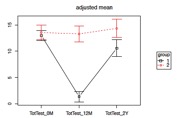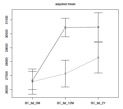Oral Presentation The Joint Annual Scientific Meetings of the Endocrine Society of Australia and the Society for Reproductive Biology 2017
Persistent adiposity 2 years after cessation of androgen deprivation therapy in men with prostate cancer. (#46)
Background: Hypogonadism from androgen deprivation therapy (ADT) for prostate cancer (typically used for 2-3 years) causes gain in fat and loss of muscle mass which is associated with increased insulin resistance and decreased physical aspects of quality of life (QoL). Whether these adverse effects improve after cessation of ADT is not known.
Methods: We studied 34 (men previously treated with ADT (cases) and 29 age- and radiotherapy-matched prostate cancer controls who never received ADT. 22 cases and 19 controls completed the study. Serum testosterone levels and body composition (using dual x-ray absorptiometry) were measured at commencement of ADT, 1 year after commencing ADT and 2 years after ADT cessation in cases, and at equivalent timepoints in controls. Using a mixed model, the mean adjusted difference (MAD [95% CI]) between groups from 0 to 4 years are reported.
Results:
Median duration of ADT was 2.4 years (IQR 1.7, 3.2). Two years after cessation of ADT, total testosterone remained lower in cases compared to controls [Figure 1A]. Fat mass (2114g [405, 3819] p=0.03 Figure 1B) and insulin resistance (HOMA2-IR 0.64 [0.25, 1.02] p=0.003) remained higher in cases and lean mass remained reduced compared to controls. Frailty categories (Fried’s criteria) were no longer different to controls. Self-reported physical component of QoL (Short-Form 12) remained worse than controls.
Conclusion: Two years after ADT cessation, fat mass and insulin resistance in previously ADT-treated men remained elevated which may be related to incomplete testosterone recovery. Impaired physical aspects of QoL may reflect persistent body composition alterations. The potential for incomplete or delayed reversibility of ADT-associated adverse effects, if confirmed in larger studies, should be considered in the risk:benefit assessments of this treatment.
Figure 1A. 1B.
1B.